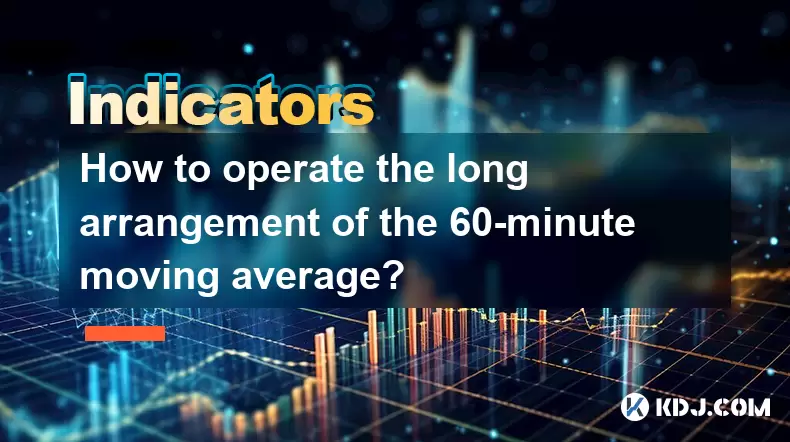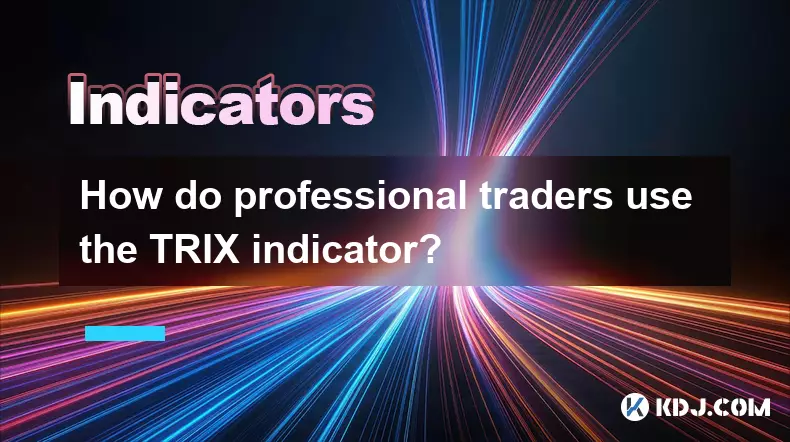-
 bitcoin
bitcoin $102877.190955 USD
1.88% -
 ethereum
ethereum $3430.435064 USD
4.52% -
 tether
tether $0.999264 USD
-0.05% -
 xrp
xrp $2.307310 USD
4.49% -
 bnb
bnb $987.740692 USD
3.82% -
 solana
solana $161.947760 USD
3.97% -
 usd-coin
usd-coin $0.999712 USD
-0.05% -
 tron
tron $0.292810 USD
2.93% -
 dogecoin
dogecoin $0.179738 USD
10.70% -
 cardano
cardano $0.580716 USD
8.75% -
 hyperliquid
hyperliquid $42.463448 USD
8.40% -
 chainlink
chainlink $15.763437 USD
7.05% -
 zcash
zcash $649.595636 USD
17.21% -
 bitcoin-cash
bitcoin-cash $511.610261 USD
7.19% -
 stellar
stellar $0.292537 USD
7.91%
How to operate the long arrangement of the 60-minute moving average?
The 60-minute moving average helps traders identify trends by smoothing price data and filtering out short-term volatility.
Jun 23, 2025 at 07:49 pm

Understanding the 60-Minute Moving Average
The 60-minute moving average is a technical analysis tool used by traders to assess the trend of a cryptocurrency over a specific time frame. It calculates the average price of an asset over the past 60 minutes and updates continuously as new data becomes available. This indicator helps smooth out short-term volatility, making it easier to identify potential uptrends or downtrends in the market.
When analyzing the 60-minute moving average, traders typically use it on candlestick charts set to the 1-hour interval. The key benefit lies in its ability to filter out noise from rapid price fluctuations, allowing for clearer decision-making. Traders often combine this with other indicators such as RSI or MACD to confirm signals before entering trades.
Setting Up Your Chart for Analysis
To begin using the 60-minute moving average, you need to configure your trading platform correctly. Most platforms like Binance, TradingView, or CoinMarketCap allow users to customize their charts. Navigate to the chart settings and ensure the time frame is set to '1 hour' (H1). Once that's confirmed, locate the moving average indicator in the list of tools provided by the platform.
Add the moving average and specify the period as 60. Some platforms might default to simple moving average (SMA), but others may offer options like exponential moving average (EMA). While both are useful, EMA gives more weight to recent prices, which can be beneficial in fast-moving crypto markets. Apply the setting and observe how the line appears on your chart, overlaying the candlesticks.
Identifying Entry Points Using the 60-Minute MA
One of the primary applications of the 60-minute moving average is identifying potential entry points for long positions. A common strategy involves watching for price crossovers above the moving average line. When the price consistently stays above the MA, it suggests a bullish trend.
Traders often wait for two or three consecutive candles to close above the 60-minute moving average before considering a buy. This confirmation helps reduce false signals. Additionally, volume should ideally increase during these crossovers, indicating stronger buyer interest. Monitoring support levels near the MA can also provide opportunities to enter at favorable prices when the price retraces to test the moving average.
Managing Risk and Stop-Loss Placement
While the 60-minute moving average can guide entry decisions, effective risk management is crucial. One method is placing stop-loss orders just below the moving average line. If the price drops below this level after entering a trade, it could signal a reversal or weakening trend.
For instance, if you entered a trade when the price crossed above the 60-minute moving average, placing your stop-loss slightly beneath the MA can help protect capital. Trailing stops can also be employed to lock in profits as the price moves favorably. Always calculate position size based on your risk tolerance, ensuring no single trade jeopardizes a significant portion of your portfolio.
Combining the 60-Minute MA with Other Indicators
Using the 60-minute moving average alone may not always yield reliable results due to market volatility. Therefore, combining it with other technical tools enhances accuracy. For example, integrating the Relative Strength Index (RSI) can help determine whether the asset is overbought or oversold.
If the price is above the 60-minute moving average and the RSI is above 50 but not yet in overbought territory (above 70), it reinforces the bullish case. Similarly, using MACD can confirm momentum shifts. Look for MACD line crossing above the signal line while the price remains above the MA. These combinations create a layered approach to trading, increasing confidence in long setups.
Frequently Asked Questions
Can I use the 60-minute moving average on different cryptocurrencies?
Yes, the 60-minute moving average applies universally across all cryptocurrencies. Whether you're trading Bitcoin, Ethereum, or altcoins, the principle remains the same. However, some assets may exhibit stronger trends than others, so backtesting on each pair is recommended before live trading.
Should I use SMA or EMA for the 60-minute moving average?
Both simple moving average (SMA) and exponential moving average (EMA) work well, but they serve slightly different purposes. EMA reacts faster to recent price changes, making it suitable for active traders seeking quick entries. SMA offers smoother signals and may suit those preferring fewer trades with higher confirmation strength.
How do I know if the 60-minute moving average is giving a false signal?
False signals occur when the price briefly crosses the 60-minute moving average but quickly reverses. To filter these, wait for multiple candlesticks to confirm the crossover. Also, check volume and align with higher time frames (like 4-hour or daily charts) to validate the trend direction.
Is the 60-minute moving average suitable for scalping strategies?
While the 60-minute moving average is more commonly used for swing trading, it can be adapted for scalping if paired with tighter time frames like 5-minute or 15-minute charts. In such cases, closely monitor order flow and liquidity to avoid slippage and enhance execution speed.
Disclaimer:info@kdj.com
The information provided is not trading advice. kdj.com does not assume any responsibility for any investments made based on the information provided in this article. Cryptocurrencies are highly volatile and it is highly recommended that you invest with caution after thorough research!
If you believe that the content used on this website infringes your copyright, please contact us immediately (info@kdj.com) and we will delete it promptly.
- BlockDAG, Avalanche, Dogecoin: Crypto's Leading Trio in 2025
- 2025-11-07 22:05:01
- Layer 2 Coins: Will There Be a Potential Explosion by 2026?
- 2025-11-07 16:50:02
- Filecoin, ICP, and the AI Infrastructure Renaissance: Is History Repeating?
- 2025-11-07 16:50:02
- Bitcoin's Wild Ride: Surges, Zeros, and the Search for Stability
- 2025-11-07 17:05:01
- XRP, Bitcoin, and the Rally: What's the Deal, New York?
- 2025-11-07 17:25:01
- Filecoin, DePIN, and a Technical Breakout: What's the Buzz?
- 2025-11-07 17:05:01
Related knowledge

How do professional traders use the TRIX indicator?
Nov 06,2025 at 04:40pm
Understanding the TRIX Indicator in Crypto TradingThe TRIX (Triple Exponential Average) indicator is a momentum oscillator used by professional trader...

Can I use the TRIX indicator on my mobile trading app?
Nov 07,2025 at 07:40pm
The TRIX indicator, a momentum oscillator designed to filter out short-term fluctuations and highlight long-term trends, has become increasingly popul...

How to code a simple TRIX indicator script in Pine Script?
Nov 07,2025 at 06:20am
How to Code a Simple TRIX Indicator in Pine Script The TRIX (Triple Exponential Moving Average) indicator is widely used in cryptocurrency trading to ...

How to trade TRIX indicator signals on the 1-hour chart?
Nov 07,2025 at 05:39am
Bitcoin's Role in Decentralized Finance1. Bitcoin remains the cornerstone of decentralized finance, serving as a benchmark for value and security acro...

Can the TRIX indicator be used for long-term investing?
Nov 06,2025 at 02:19pm
Understanding the TRIX Indicator in Cryptocurrency Markets1. The TRIX (Triple Exponential Average) indicator is a momentum oscillator designed to filt...

How to customize TRIX indicator settings for different assets?
Nov 06,2025 at 03:39pm
Understanding the TRIX Indicator in Cryptocurrency Trading1. The TRIX (Triple Exponential Average) indicator is a momentum oscillator designed to filt...

How do professional traders use the TRIX indicator?
Nov 06,2025 at 04:40pm
Understanding the TRIX Indicator in Crypto TradingThe TRIX (Triple Exponential Average) indicator is a momentum oscillator used by professional trader...

Can I use the TRIX indicator on my mobile trading app?
Nov 07,2025 at 07:40pm
The TRIX indicator, a momentum oscillator designed to filter out short-term fluctuations and highlight long-term trends, has become increasingly popul...

How to code a simple TRIX indicator script in Pine Script?
Nov 07,2025 at 06:20am
How to Code a Simple TRIX Indicator in Pine Script The TRIX (Triple Exponential Moving Average) indicator is widely used in cryptocurrency trading to ...

How to trade TRIX indicator signals on the 1-hour chart?
Nov 07,2025 at 05:39am
Bitcoin's Role in Decentralized Finance1. Bitcoin remains the cornerstone of decentralized finance, serving as a benchmark for value and security acro...

Can the TRIX indicator be used for long-term investing?
Nov 06,2025 at 02:19pm
Understanding the TRIX Indicator in Cryptocurrency Markets1. The TRIX (Triple Exponential Average) indicator is a momentum oscillator designed to filt...

How to customize TRIX indicator settings for different assets?
Nov 06,2025 at 03:39pm
Understanding the TRIX Indicator in Cryptocurrency Trading1. The TRIX (Triple Exponential Average) indicator is a momentum oscillator designed to filt...
See all articles





















![The Graph Price Prediction [GRT Crypto Price News Today] The Graph Price Prediction [GRT Crypto Price News Today]](/uploads/2025/11/07/cryptocurrencies-news/videos/690d4df44fe69_image_500_375.webp)



















































